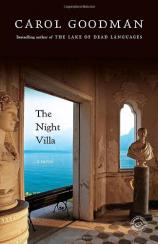The Night Villa
Review
The Night Villa
THE NIGHT VILLA, award-winning author Carol Goodman’s
sixth novel, begins with a tragic shooting on the campus of the
University of Texas in Austin. It involves the jealous ex-boyfriend
of student Agnes Hancock, who opens fire on a classroom filled with
students and teachers, and ends up taking two lives before turning
the gun on himself. Injured in the attack is Dr. Sophie Chase, who
bravely attempted to thwart shooter Dale Henry and ends up being
shot in the chest, causing serious damage to her lungs.
In the aftermath of this tragedy, Dr. Elgin Lawrence puts
together a team of experts (archaeologists, historians, theologians
and a student) to travel to Italy as part of a project sponsored by
a philanthropic billionaire. Dubbed the Papyrus Project, it
revolves around the use of new spectrograph technology that allows
ancient scrolls to be scanned and interpreted. The texts in
question are located in the Villa della Notte --- the Night Villa
--- and had been buried under centuries of ash and debris following
the devastating eruption of Mt. Vesuvius in A.D. 79.
The narrator, and main focus, of THE NIGHT VILLA is Dr. Sophie
Chase, and her reason for participating in the excavation is not
just to escape the tragic campus shooting. Sophie also leaves
behind the memory of her former lover, Ely Markowitz, who she has
lost to his obsession with the Tetraktys, a cult that worships and
follows the teaching of Pythagoras. The ritual of becoming a
full-fledged Tetrakty consists of immersion at one of their
communes and a five-year vow of total silence with no communication
to the outside world. With Ely all but lost to Sophie forever, she
has renewed interest in joining the Papyrus Project. During the
excavation of the scrolls found at the Night Villa, an ancient
story begins to reveal itself --- a diary scribed by Phineas in
A.D. 79 that prominently features a young slave girl named Iusta
--- and unearths a subterranean labyrinth that provides the team
with further documents believed lost forever.
Iusta’s story is captivating as she proves to be more than
just a simple slave girl. She is a strong-willed woman who seeks to
win her own freedom from slavery in events that defy the pagan
beliefs and rituals of the time and may potentially rewrite
Italy’s religious history in the process. What is more
striking are the similarities that Iusta’s tale has with the
lives of both Dr. Sophie Chase and Agnes Hancock --- two modern
women seeking to change their lives while revealing secrets of the
past. What transpires at this point is an engaging mystery where
revealing the secrets of the scrolls ends up being only one of the
issues the team faces.
Goodman’s books always involve characters who are complex
and whose present lives seem to be incomplete until past histories
are revealed and understood. The parallel stories of Sophie and
Agnes with the ancient tale of Iusta is utterly fascinating, and
the novel switches back and forth at times between present day and
the deciphering of the latest set of ancient scrolls. Readers may
easily lose sight of the fact that they are involved in a
page-turning mystery as they become further immersed in the stories
of these deeply layered characters who never cease to surprise
you.
Being a fellow Long Islander, I had the opportunity to speak
with Carol Goodman regarding the impetus for THE NIGHT VILLA. In
addition to her degree in Latin, she also has extensive knowledge
of Italy, having conducted research there for her prior novel, THE
SONNET LOVER. It was during the book tour for THE SONNET LOVER that
she met up with an old friend and Greek professor who told her
about the Papyrus Project. Regrettably, he passed away in March
2008 and is named in the book’s acknowledgements.
Goodman’s husband, Lee, even gets into the act, having penned
the poems that are included here.
Goodman’s novels always radiate with the tradition of
Gothic literature made famous by authors like Charlotte Bronte and
Daphne du Maurier, and THE NIGHT VILLA continues this tradition in
admirable style.
Reviewed by Ray Palen on January 13, 2011




